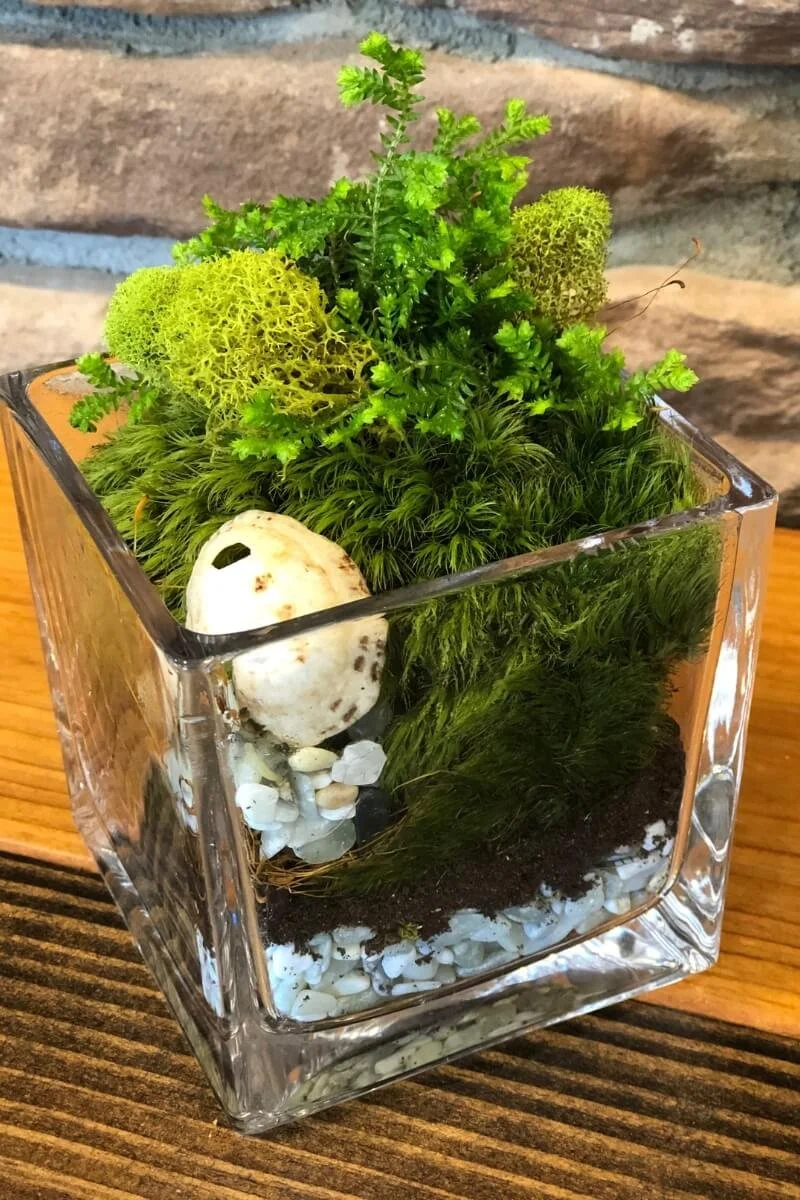Create Your Own St. Patrick's Day Terrarium in A Vase
A Unique Terrarium Idea to Honor the Emerald Isle
Get step-by-step instructions for creating a mossy green open terrarium in a vase.
Terrarium Vase Materials:
One 4-inch square glass vase
Decorative jade bean pebbles, 1/5-inch size
A small piece of landscape fabric, cut to approximately 3.75-inches square (slightly less than the size of your vase)
Potting soil
1 spike moss plant (Selaginella kraussiana), 2-inch pot size. If selaginella is not available, any 2” fern will work.
Live mood moss - one piece, approximately 5-inches square
A small shell
Chartreuse preserved reindeer moss
The above materials list provides specific items featured in the photo, but you can easily adapt the project with what you have on hand.
For example, instead of selaginella, small ferns or 2-inch terrarium plants work just as well. If you don't have jade pebbles, you can substitute small white or tan pebbles. Instead of a shell, you can use other small Irish or St. Patrick’s day-themed items you may already have, or even tiny fairy garden miniatures.
To make it even more fun for kids, you could add a tiny plastic leprechaun or a miniature pot of gold for a whimsical touch. Feel free to get creative and personalize the project!
If you are wondering where to buy supplies for this project, jade bean pebbles and preserved reindeer moss are available to buy anywhere floral supplies are sold, such as craft stores or online retailers. Live mood moss is available to buy online or at local nurseries and floral shops.
Read on for instructions on how to assemble this vase terrarium!
St. Patrick's Day Vase Terrarium, a mini-homage to the beauty of Ireland.
How to Make Your Own Terrarium Vase:
Clean the vase in hot, soapy water and dry with a towel. If needed, use a glass cleaner to remove any streaks from the glass.
Add a layer of jade bean pebbles to the bottom of the vase. Aim for a layer that is approximately 1/2-inch thick.
Gently place the piece of landscape fabric on top of the pebbles. This is to prevent potting soil from washing into the jade pebbles.
Add approximately 2 inches of potting soil on top of the landscape fabric. Take care to gently add the soil and ensure that the landscape fabric stays in place and does not shift around. You can create a topography to the soil, if desired - it adds drama and interest to the terrarium vase. Build the soil high in one corner, and low in the opposite corner. Use the soil to keep the landscape fabric covered from view as well.
Plant the selaginalla in the higher corner: first, loosen and remove some potting soil from around the roots of the selaginella as you remove it from the plastic nursery pot - the less soil you have around the roots, the easier it will be to fit in the terrarium vase. Use a pencil or chopstick to slowly and carefully make a planting hole, and carefully set the selaginella plant inside. Gently tamp down the dirt around the base of the plant.
Cover the exposed dirt areas with live mood moss, using scissors to trim long roots off the bottom and to size as needed. Leave the dirt around the fern exposed - it will be hidden with reindeer moss. Gently press the mood moss down so it makes good contact with the dirt - this will help it to grow and stay fresh for a longer period of time. Press down the edges of the mood moss as needed with a pencil or chopstick, so the edges have a clean look when viewed through the glass.
Add a few jade pebbles and the shell to the low area of the garden. Add 1-3 pieces of reindeer moss to the areas around the fern, to cover up the dirt.
Clean the outside of the glass vase again, if needed.
How Do I Take Care of My Terrarium Vase?
To keep your miniature garden looking as green as possible, place it in bright, indirect sunlight. Direct sun will scorch the spike moss. Both the spike moss and mood moss like to stay evenly moist and appreciate humidity, so don’t put this garden in a corner and forget about it! Place it in an area you frequent, so you will remember to check on it.
The trick to watering this open terrarium is to give it just enough water to keep the potting soil evenly moist (about 2-4 tablespoons worth of room temperature water, a few times a week), but not so much that the water runs right through to the stones on the bottom.
Remember, this vase does not have drainage so you will need to experiment and calibrate just how much water is enough. Frequent misting will also help this garden look it’s best.
You may want to treat this type of terrarium as a seasonal decoration - something to be enjoyed in the month of March, then be disassembled and repurposed. The spike moss can be potted in another container with a drainage hole and treated as a houseplant or saved for another terrarium. The mood moss can be kept in the refrigerator for a few weeks, until needed again for another project.
You may also decide to maintain the terrarium in its current state for an extended period of time. With proper care and attention, a well-maintained terrarium can last for a long time - potentially several years or more!

